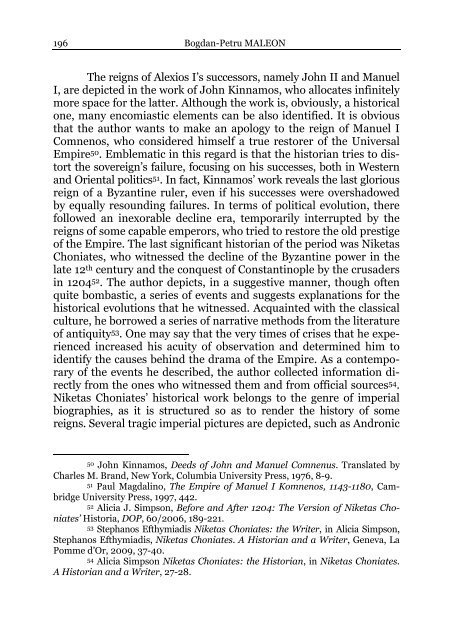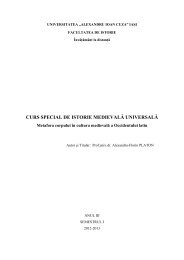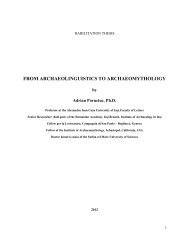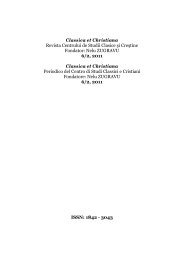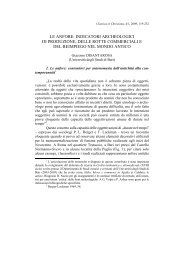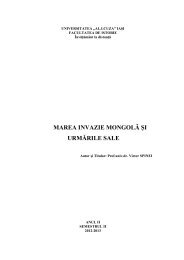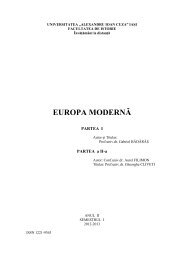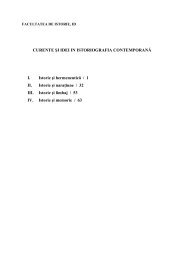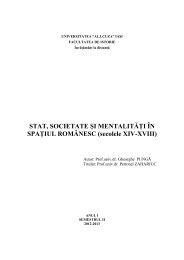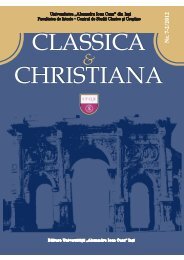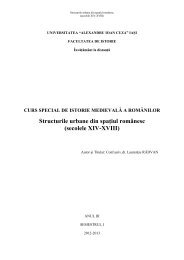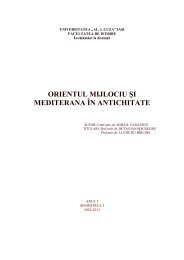- Page 3 and 4:
Classica et Christiana Revista Cent
- Page 5 and 6:
UNIVERSITATEA „ALEXANDRU IOAN CUZ
- Page 7 and 8:
SUMAR / INDICE SIGLE ŞI ABREVIERI
- Page 9:
AIIAI BHAC BHL CCSL CI CSEL DACL DH
- Page 13 and 14:
PROGRAM / PROGRAMMA 11 Luni / Luned
- Page 15:
13.00-18.00: Vizite la monumente is
- Page 18 and 19:
16 Immacolata AULISA 1. Alle origin
- Page 20 and 21:
18 Immacolata AULISA Durante i prim
- Page 22 and 23:
20 Immacolata AULISA martyris passi
- Page 24 and 25:
22 Immacolata AULISA da parte dell
- Page 26 and 27:
24 Immacolata AULISA lezza fisica s
- Page 28 and 29:
26 Immacolata AULISA illustra anche
- Page 30 and 31:
28 Immacolata AULISA prima della su
- Page 32 and 33:
30 Immacolata AULISA tica o militar
- Page 34 and 35:
32 Immacolata AULISA tore è attent
- Page 36 and 37:
34 Immacolata AULISA sidio, inoltre
- Page 38 and 39:
36 Immacolata AULISA quanto si ebbe
- Page 40 and 41:
38 Immacolata AULISA cando luoghi,
- Page 42 and 43:
40 Immacolata AULISA quella di Mone
- Page 44 and 45:
42 Immacolata AULISA sieme ai giude
- Page 46 and 47:
44 Immacolata AULISA di generi biog
- Page 48 and 49:
46 Immacolata AULISA tico imperiale
- Page 50 and 51:
48 Antonella BRUZZONE 1. I Furii po
- Page 52 and 53:
50 Antonella BRUZZONE Anziate sareb
- Page 54 and 55:
52 Antonella BRUZZONE Scholia Veron
- Page 56 and 57:
54 Antonella BRUZZONE 3. Le dimensi
- Page 58 and 59:
56 Antonella BRUZZONE Caesarum legu
- Page 60 and 61:
58 Antonella BRUZZONE (un verso che
- Page 62 and 63:
60 Antonella BRUZZONE Come avremo m
- Page 64 and 65:
62 Antonella BRUZZONE Fr. 11 Bläns
- Page 66 and 67:
64 Antonella BRUZZONE scia per port
- Page 68 and 69:
66 Antonella BRUZZONE Nel fr. 10 pr
- Page 70 and 71:
68 Antonella BRUZZONE e) Furio Anzi
- Page 72 and 73:
70 Antonella BRUZZONE Hildebrand 18
- Page 75 and 76:
Classica et Christiana, 8/1, 2013,
- Page 77 and 78:
LA PROSOPOGRAPHIE DES FEMMES EN MÉ
- Page 79 and 80:
LA PROSOPOGRAPHIE DES FEMMES EN MÉ
- Page 81 and 82:
LA PROSOPOGRAPHIE DES FEMMES EN MÉ
- Page 83 and 84:
Classica et Christiana, 8/1, 2013,
- Page 85 and 86:
THE GENEALOGIE OF GILGAMESH A lot o
- Page 87 and 88:
THE GENEALOGIE OF GILGAMESH wants t
- Page 89 and 90:
THE GENEALOGIE OF GILGAMESH and wer
- Page 91 and 92:
THE GENEALOGIE OF GILGAMESH her del
- Page 93 and 94:
THE GENEALOGIE OF GILGAMESH the mig
- Page 95 and 96:
THE GENEALOGIE OF GILGAMESH SKL 39
- Page 97 and 98:
THE GENEALOGIE OF GILGAMESH ba.an.k
- Page 99 and 100:
THE GENEALOGIE OF GILGAMESH A might
- Page 101 and 102:
THE GENEALOGIE OF GILGAMESH 2. The
- Page 103 and 104:
5.2. The wet-nurse THE GENEALOGIE O
- Page 105 and 106:
THE GENEALOGIE OF GILGAMESH Gilgame
- Page 107 and 108:
THE GENEALOGIE OF GILGAMESH Lang /
- Page 109:
THE GENEALOGIE OF GILGAMESH Vanstip
- Page 112 and 113:
110 Mario GIRARDI vescovo (presumib
- Page 114 and 115:
112 Mario GIRARDI ne mss. dell’ep
- Page 116 and 117:
114 Mario GIRARDI Iunius Soranus, l
- Page 118 and 119:
116 Mario GIRARDI più di uno studi
- Page 120 and 121:
118 Mario GIRARDI ¢le…pthj, l’
- Page 122 and 123:
120 Mario GIRARDI volta anche per r
- Page 124 and 125:
122 Mario GIRARDI ¢le…ptou) che
- Page 126 and 127:
124 Mario GIRARDI 3. ¢le…pthj ne
- Page 128 and 129:
126 Mario GIRARDI va 62 , e che per
- Page 130 and 131:
128 Mario GIRARDI nostro caso è sp
- Page 132 and 133:
130 Ştefan S. GOROVEI de le faire.
- Page 134 and 135:
132 Ştefan S. GOROVEI Empire, init
- Page 136 and 137:
134 Ştefan S. GOROVEI des recherch
- Page 138 and 139:
136 Ştefan S. GOROVEI un programme
- Page 140 and 141:
138 Ştefan S. GOROVEI de travail s
- Page 142 and 143:
140 Ştefan S. GOROVEI Jérémie. L
- Page 144 and 145:
142 Ştefan S. GOROVEI chaque jour,
- Page 146 and 147:
144 Ştefan S. GOROVEI Je n’ai pa
- Page 148 and 149: 146 Olimpia IMPERIO Che Pericle sia
- Page 150 and 151: 148 Olimpia IMPERIO qui l’ambigui
- Page 152 and 153: 150 Olimpia IMPERIO più riprese ri
- Page 154 and 155: 152 Olimpia IMPERIO Analogamente, n
- Page 156 and 157: 154 Olimpia IMPERIO per quanto poi
- Page 158 and 159: 156 Olimpia IMPERIO altrui e a sosp
- Page 160 and 161: 158 Olimpia IMPERIO È pertanto dif
- Page 162 and 163: 160 Olimpia IMPERIO sieme con Ermes
- Page 164 and 165: 162 Olimpia IMPERIO poetologici o s
- Page 166 and 167: 164 Olimpia IMPERIO rotta del vero
- Page 168 and 169: 166 Olimpia IMPERIO precedente crat
- Page 170 and 171: 168 Olimpia IMPERIO peculiarità co
- Page 172 and 173: 170 Olimpia IMPERIO L’integrazion
- Page 174 and 175: 172 Olimpia IMPERIO via a datare il
- Page 176 and 177: 174 Olimpia IMPERIO l’Alessandro
- Page 178 and 179: 176 Domenico LASSANDRO Questo giudi
- Page 180 and 181: 178 Domenico LASSANDRO mento delle
- Page 182 and 183: 180 Domenico LASSANDRO que danno e
- Page 184 and 185: 182 Domenico LASSANDRO La scultura
- Page 186 and 187: 184 Domenico LASSANDRO torno al 440
- Page 189 and 190: Classica et Christiana, 8/1, 2013,
- Page 191 and 192: BYZANTINE IMPERIAL BIOGRAPHIES rowe
- Page 193 and 194: BYZANTINE IMPERIAL BIOGRAPHIES his
- Page 195 and 196: BYZANTINE IMPERIAL BIOGRAPHIES anit
- Page 197: BYZANTINE IMPERIAL BIOGRAPHIES Alex
- Page 201 and 202: Classica et Christiana, 8/1, 2013,
- Page 203 and 204: GLI APOLLINARI 201 Apollinare, avo
- Page 205 and 206: GLI APOLLINARI 203 tafio da lui com
- Page 207 and 208: GLI APOLLINARI 205 peraltro, si era
- Page 209 and 210: GLI APOLLINARI 207 incarico di trib
- Page 211 and 212: GLI APOLLINARI 209 471 e nel 474 31
- Page 213 and 214: GLI APOLLINARI 211 cos incitata doc
- Page 215 and 216: GLI APOLLINARI 213 rapporti con l
- Page 217 and 218: Classica et Christiana, 8/1, 2013,
- Page 219 and 220: ELEMENTI PROTRETTICI E BIOGRAFICI N
- Page 221 and 222: ELEMENTI PROTRETTICI E BIOGRAFICI N
- Page 223 and 224: ELEMENTI PROTRETTICI E BIOGRAFICI N
- Page 225 and 226: ELEMENTI PROTRETTICI E BIOGRAFICI N
- Page 227 and 228: ELEMENTI PROTRETTICI E BIOGRAFICI N
- Page 229: ELEMENTI PROTRETTICI E BIOGRAFICI N
- Page 232 and 233: 230 Premessa Giovanni Antonio NIGRO
- Page 234 and 235: 232 Giovanni Antonio NIGRO chico, i
- Page 236 and 237: 234 Giovanni Antonio NIGRO tichi. L
- Page 238 and 239: 236 Giovanni Antonio NIGRO il buon
- Page 240 and 241: 238 Giovanni Antonio NIGRO renze pa
- Page 242 and 243: 240 Giovanni Antonio NIGRO di allon
- Page 244 and 245: 242 Giovanni Antonio NIGRO Istituzi
- Page 246 and 247: 244 Giovanni Antonio NIGRO aprile)
- Page 248 and 249:
246 Giovanni Antonio NIGRO più uma
- Page 250 and 251:
248 Giovanni Antonio NIGRO mento in
- Page 252 and 253:
250 Giovanni Antonio NIGRO decina d
- Page 254 and 255:
252 Giovanni Antonio NIGRO della fe
- Page 256 and 257:
254 Giovanni Antonio NIGRO Giuliano
- Page 258 and 259:
256 Giovanni Antonio NIGRO minare C
- Page 260 and 261:
258 Giovanni Antonio NIGRO al sacer
- Page 262 and 263:
260 Giovanni Antonio NIGRO severi g
- Page 264 and 265:
262 Giovanni Antonio NIGRO riorgani
- Page 266 and 267:
264 Giovanni Antonio NIGRO dell’i
- Page 268 and 269:
266 Giovanni Antonio NIGRO pefatto
- Page 270 and 271:
268 Giovanni Antonio NIGRO dossia n
- Page 273 and 274:
Classica et Christiana, 8/1, 2013,
- Page 275 and 276:
THE SENATORIAL ARISTOCRACY IN THE F
- Page 277 and 278:
THE SENATORIAL ARISTOCRACY IN THE F
- Page 279 and 280:
THE SENATORIAL ARISTOCRACY IN THE F
- Page 281 and 282:
THE SENATORIAL ARISTOCRACY IN THE F
- Page 283 and 284:
THE SENATORIAL ARISTOCRACY IN THE F
- Page 285 and 286:
THE SENATORIAL ARISTOCRACY IN THE F
- Page 287:
THE SENATORIAL ARISTOCRACY IN THE F
- Page 290 and 291:
288 Daniele Vittorio PIACENTE Il qu
- Page 292 and 293:
290 Daniele Vittorio PIACENTE biand
- Page 294 and 295:
292 Daniele Vittorio PIACENTE compl
- Page 296 and 297:
294 Daniele Vittorio PIACENTE imper
- Page 298 and 299:
296 Daniele Vittorio PIACENTE colta
- Page 300 and 301:
298 Daniele Vittorio PIACENTE grego
- Page 302 and 303:
300 Anna Maria PIREDDA hanno attrib
- Page 304 and 305:
302 Anna Maria PIREDDA seri parente
- Page 306 and 307:
304 Anna Maria PIREDDA martire e si
- Page 308 and 309:
306 Anna Maria PIREDDA sio Fabii so
- Page 310 and 311:
308 Anna Maria PIREDDA disti; et ni
- Page 312 and 313:
310 Anna Maria PIREDDA valenza simb
- Page 314 and 315:
312 Anna Maria PIREDDA fratris il
- Page 316 and 317:
314 Anna Maria PIREDDA nella Passio
- Page 318 and 319:
316 Anna Maria PIREDDA Questo scrit
- Page 320 and 321:
318 Claudia TĂRNĂUCEANU Aulae Oth
- Page 322 and 323:
320 Claudia TĂRNĂUCEANU Gregoras,
- Page 324 and 325:
322 Claudia TĂRNĂUCEANU chronique
- Page 326 and 327:
324 Claudia TĂRNĂUCEANU La premi
- Page 328 and 329:
326 Claudia TĂRNĂUCEANU brièveme
- Page 330 and 331:
328 Claudia TĂRNĂUCEANU III, 146-
- Page 332 and 333:
330 Claudia TĂRNĂUCEANU Général
- Page 334 and 335:
332 Claudia TĂRNĂUCEANU aux priè
- Page 336 and 337:
334 Claudia TĂRNĂUCEANU se basant
- Page 339 and 340:
Classica et Christiana, 8/1, 2013,
- Page 341 and 342:
ALESSANDRO NEI EPITOMATORI TARDOANT
- Page 343 and 344:
ALESSANDRO NEI EPITOMATORI TARDOANT
- Page 345 and 346:
ALESSANDRO NEI EPITOMATORI TARDOANT
- Page 347 and 348:
ALESSANDRO NEI EPITOMATORI TARDOANT
- Page 349 and 350:
ALESSANDRO NEI EPITOMATORI TARDOANT
- Page 351 and 352:
ALESSANDRO NEI EPITOMATORI TARDOANT
- Page 353 and 354:
ALESSANDRO NEI EPITOMATORI TARDOANT
- Page 355 and 356:
ALESSANDRO NEI EPITOMATORI TARDOANT
- Page 357 and 358:
ALESSANDRO NEI EPITOMATORI TARDOANT
- Page 359 and 360:
ALESSANDRO NEI EPITOMATORI TARDOANT
- Page 361 and 362:
ALESSANDRO NEI EPITOMATORI TARDOANT
- Page 363 and 364:
ALESSANDRO NEI EPITOMATORI TARDOANT
- Page 365 and 366:
8. Colonna Traiana ALESSANDRO NEI E
- Page 367:
ALESSANDRO NEI EPITOMATORI TARDOANT


